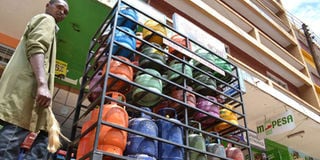Premium
Households stick with LPG despite rising cost

A trader displays cooking gas cylinders.
What you need to know:
- Energy regulator indicates that LPG use hit a new high of 373,865 tonnes in 2021.
- Price of a 13kg LPG cylinder shot up by 27 per cent to Sh2,638 in December last year.
Consumption of Liquefied Petroleum Gas (LPG) rose by 16.5 per cent last year to a record high, data by the Energy and Petroleum Regulatory Authority (Epra) shows, signalling the burden on households facing rising prices of the five major cooking energy sources.
The regulator indicated that LPG use hit a new high of 373,865 tonnes in 2021, up from 320,909 in the previous year, despite the higher cost of the commodity.
At the same time, another set of data from the Kenya National Bureau of Statistics (KNBS) shows the price of a 13kg LPG cylinder shot up by 27 per cent to Sh2,638 in December last year, up from Sh2,074 in June just before the new tax measure took effect.
The increased LPG consumption comes as users were also struck with an increase in the prices of charcoal and kerosene, the cheaper alternatives to which poor households would shift. The prices of electricity, another cooking energy source, also rose sharply, driven by a rapid rise in global crude oil prices that increased local thermal power production costs.
KNBS says the prices of a kilo of charcoal rose by five per cent to an average of Sh60 in December last year, up from Sh57 per kilogramme in the previous year.
The cost of kerosene also increased by 26 per cent in the same period to Sh106 per litre, up from Sh84 in the previous year, forcing many households to stick with LPG for their cooking needs.
LPG consumption
The increased consumption comes despite the reintroduction of the 16 per cent value-added tax (VAT) on LPG by the government that came into effect in July last year that significantly increased the price of the commodity to levels last seen in 2016 before the government scrapped the tax to boost its uptake.
The new tax was expected to reduce LPG consumption with households switching back to the use of charcoal, kerosene, and firewood, as well as higher uptake of electricity for cooking.
LPG consumption has grown significantly from 93,600 tonnes in 2012, driven by an increase in the number of LPG importers that has increased competition in the energy sub-sector, as well as reluctance by the government to introduce price controls as is the case with fuel in a bid to increase private sector investment.
On Thursday, the Kenya Institute of Public Policy Research and Analysis (Kippra), a public policy think tank at the Treasury queried Epra on the impact the new VAT has had on LPG consumption.
“Have you done a scenario analysis to check how the new tax on LPG has influenced its consumption by users across the country?” asked Kippra.
However, Epra said the use of fuel for cooking will continue its year-on-year rise despite the high taxes.
“Yes we are working on a paper on that (on the effects of new taxes on LPG use) and once we finish the findings we will let you know,” said John Mutua, Epra’s deputy director for Research and Policy Analysis.





